
The Last Redoubt
March 28, 2023
The Six Secrets of Chimera Company
August 30, 2023#1 – “I’ve got your six…”
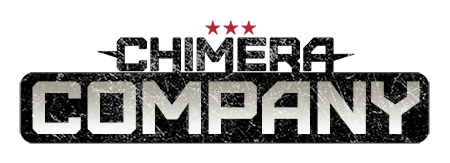
Stand by for Exciter
The factional nightmare of Warhammer 40,000…
The lived-in galaxy of adventure of Star Wars…
And as we shall see, a pinch of Lord of the Rings…
Yes, it’s Chimera Company.
August 18th, 2023 sees the release of the sixth and final book in the series: The Last Redoubt.
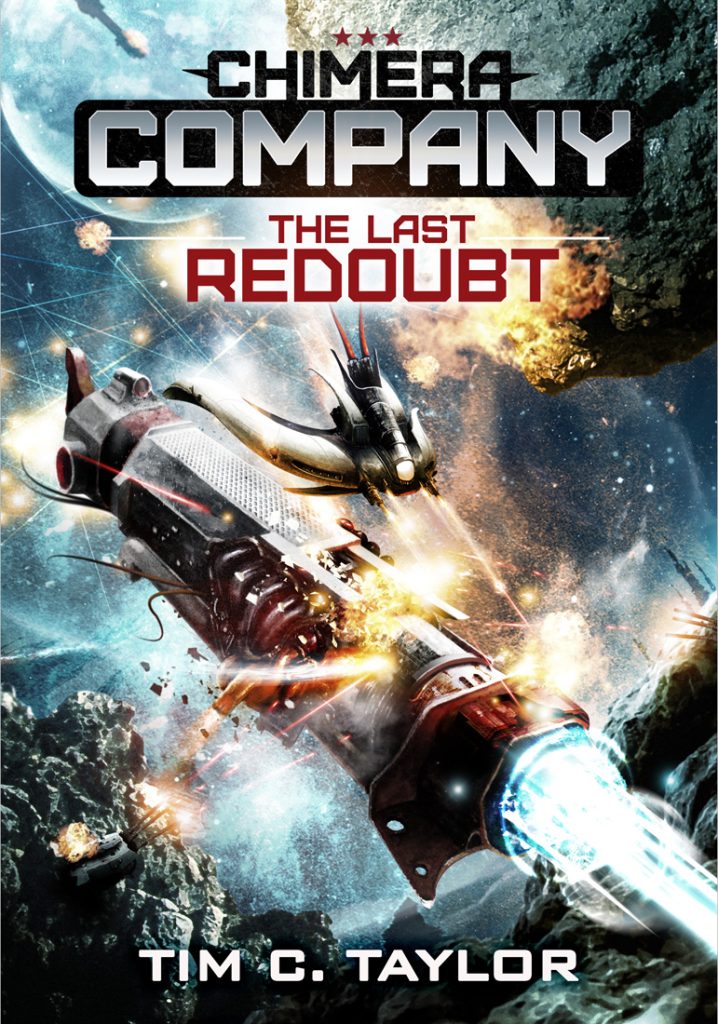
To mark the end of the series, and to get you juiced up to read, I’ll be publishing the Six Secrets of Chimera Company.
In it, I’ll be delving into one aspect of the series that I find particularly cool, and then spilling a few secrets for each book in turn.
If you just want to race ahead and buy the book, here’s the series link on Amazon
Amazon.com | amazon.co.uk | amazon.oz | amazon.ca
You can also try out the series by reading one of the three Chimera Company prequel novelettes (one for each of the following three factions: Legion, Militia, and Special Missions Executive). To get the prequels delivered to your device, Join the Legion here.
Better by You, Better than Me
Cinema abounds with buddy movies. Always has – the first Laurel & Hardy was in 1927, so I’m hardly making a startling new revelation.
Stan and Olly, of course, were a comedy duo, and back in 1927 their hilarious banter was a treat cinema goers had to wait for because we were still in the silent era and the comedy was physical. Of course, there are other types of popular pairings: romantic, sibling, crime and cop buddy movies and plenty more.
The first Star Wars film doesn’t center on one pairing, but has plenty: Han and Chewbacca, Luke and Obi Wan, and then there’s R2-D2 and C-3PO who I always felt echoed Stan and Olly.
What is the timeless appeal of the buddy movie?
If I were writing for a pretentious magazine, I would write something like this: audiences relate to the complexities of friendship and collaboration, finding comfort in the idea that even the most disparate individuals can find common ground. The humor that arises from their interactions and the growth they experience reminds us of the transformative power of human connections.
Fortunately for all concerned, I write novels. Novels that often feature pew-pew and cool spacecraft. Consequently, I’m better placed to see life how it really is.
For most people, the most important part of their lives – the part that actually counts for something – consists mainly of relationships with other individuals. There’s your core set: husband, daughter, God etc. And then there’s everyone else.
We all want a good set of mates in our lives. People that fascinate and amuse us. Friends we can share our troubles and passions with and make us laugh over a coffee or a pint.
And that’s why we like buddy movies.
Because for the two hours or so we’re munching popcorn in the movie theater, we experience through the on-screen characters the kind of friendship we want more of in real life.
I would argue that there’s a problem with buddy movies, though.
We’ve seen them a million times, so we know all the tropes, and with other thrills and drama to deliver over the course of two hours, there isn’t much screen time to do the relationship justice. It often feels rushed and cliched. We rely on the skill of the actors and the audience’s familiarity of the tropes to smooth over the gaps that there wasn’t time to fit into the script.
Enter the novel!
Holmes and Watson, Frodo and Sam, Jeeves and Wooster, Sybutu and Arunsen: I love the literary equivalent of the buddy movie because there’s more space in a book to develop the relationships realistically and have a fun time while we’re at it. Best of all for me are the ‘unlikely pairings’, and in a novel you have more space for the fun while the characters misunderstand each other because of their wildly different backgrounds. When the characters are forced to get along, it makes them search who they are and seek some kind of compromise.
In other words, we still experience the friendship we want in our own lives, but in a well-written novel we experience it at a deeper level (and for longer) than we do with a movie.
And if that’s true for a novel, then surely it will work better still with a series of novels???
That was my thinking when I developed the original Chimera Company concept.
But what is a Chimera?
Victim of Changes
The Chimera is a mythical Greek hybrid creature that combines a lion with a goat (and possibly a snake too). But the idea of hybrid creatures occurs across history in many cultures and still does today (Disney just proved my point by releasing a movie about a human-fish chimera creature).
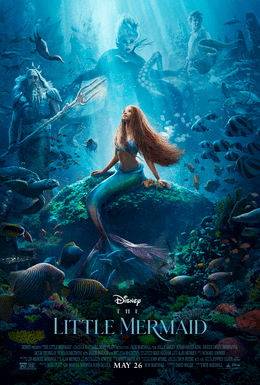
I planned for all the members of Chimera Company to have their own very distinctive backgrounds and perspectives, and they would be forced to work together despite many of them hating each other.
The external pressure that forces them together like metamorphic rock would be combat.
At this point, I’m indebted to Phillip Richards and his excellent Union series. He told me that the first part of his first book, C.R.O.W. (Combat Replacement of War), was a partially autobiographical retelling of his experiences in the British Army. It’s one of the most honest depictions I know of an intense experience, such as combat, utterly transforming people and the relationships between them. And that most definitely includes those who don’t like each other.
All this was swirling around my head as I started to write Chimera Company.

(Take These) Chains
In space opera and military sf you will encounter many teams of adventurers or military squads in which everyone watches out for each other. They’ve got your six you have theirs. Everybody stakes their life on it because the team will only survive if everyone watches out for each other.
But what if the person who has your six is the person you dislike most in the entire universe?
Enter Sergeant Vetch Arunsen, convicted thief and thought criminal, sentence commuted in return service in the Militia, a corrupt military organization frequently run for the political or financial gain of the galactic establishment.
The Militia is despised by the Legion, a rivalry that dates back three thousand years. The Legion is into shiny armor, buzzcut hair, discipline, and professionalism. The Legion is epitomized by Sergeant Oso Sybutu.
I had a lot of fun playing around with the two sergeants and one of the things I soon picked up on was that they are essentially the same person but from completely different backgrounds.
I can see that. The readers can see that. Even the other members of Chimera Company do, but the two sergeants refuse to accept that.
The relationship between Osu and Vetch is one of the key themes in the first book and – spoiler – it’s there at the very end of the last book, where their ability to work together or not will determine the fate of trillions.
Having six books to work with, I can make the development of this awkward pairing richer and more believable. I can ease it into the background in the middle books so I can focus on other parts of the story, but it’s always there, slowly maturing.
So don’t expect Vetch and Osu to be sitting around the campfire toasting marshmallows and singing Kumbaya by the end of book 1, because I’m not as rushed as those buddy movies.
I play with other partnerships too. Captain Fitz and Izza Zan Fey – the married smuggler jocks in the tradition of Han Solo, Vetch and the sublime cat assassin who develops an unlike obsession, Zaydok and Squids – the Milita gunner and the rebel mutant soldier, and my favorite Yat Darant, a Militia trooper I originally planned to kill off in book 1 but develops partnerships with both Hubert the lethal alien goat with a taste of whiskey and Claudio Zanitch, the mutant chronicler and gun fetishist.
When you plan a book series, some of the ideas that excited you to write it in the first place don’t last the full distance. Perhaps there wasn’t as much rich storytelling to it as you initially thought, or often something else reveals itself as you write the books that is even more exciting.
I’m very pleased that I felt the partnership of Vetch and Osu worked absolutely perfectly and as I always intended. For my book series, that’s as rare as opticians for basilisks.
Out in the Cold
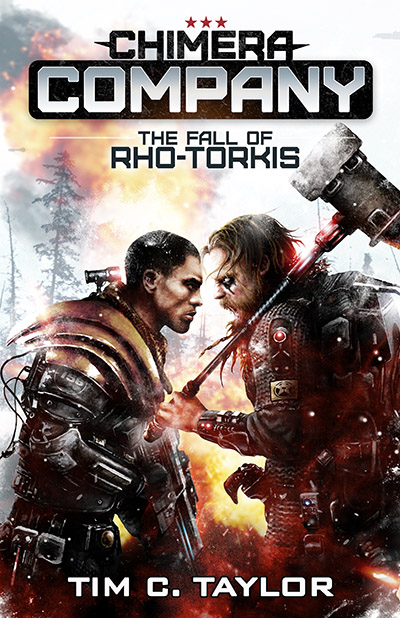
The Fall of Rho-Torkis Artwork
For the Fall of Rho-Torkis cover, artist Vincent Sammy captures the distinction between the two main characters in the visual style.
Osu Sybutu is all shiny military science-fiction, the kind of figure you see on many space marine novels and console games.
Vetch isn’t. The war hammer was a bit of artistic license I asked him to fit in, but with his electro-chainmail he’s almost mediaeval. Note the rucksack. What’s more, in the first sketch of Vetch that Vincent illustrated, I like the water bottle dangling from the ruck.
Like this…

For me, this sums up their difference perfectly. Science fiction space marines like Osu wear armor and carry a blaster rifle, they don’t have to carry the mundane details of life around the galaxy. It would spoil their tailoring.
Vetch is from the Militia. As he marches across the galaxy, he’s carrying his bed roll, water bottle, spare socks, and a dented old metal bowl. Probably an illicit bottle of brandy too, the rascal. My touchpoint with Vetch was that he’s the kind of soldier who carries a darning kit around the galaxy because there’s no one else going to mend his clothes but him.
By the way… keep close eye on the Rho-Torkis book cover. Memorize it. When you’ve read the series all the way to the end, you will realize that is far more than just a picture on a book cover….
NEXT TIME…
I invent the Uranium Principle of writing… during trench warfare four kilometers up in the Alps.



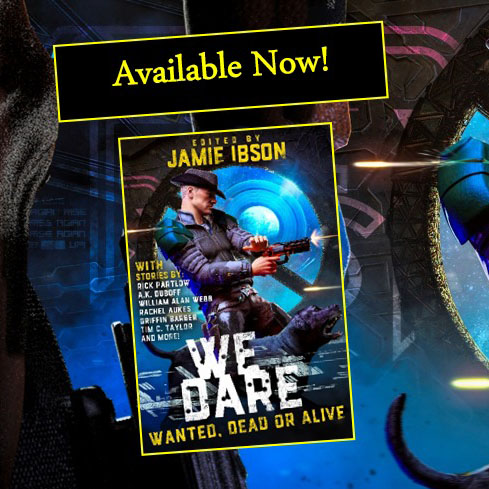
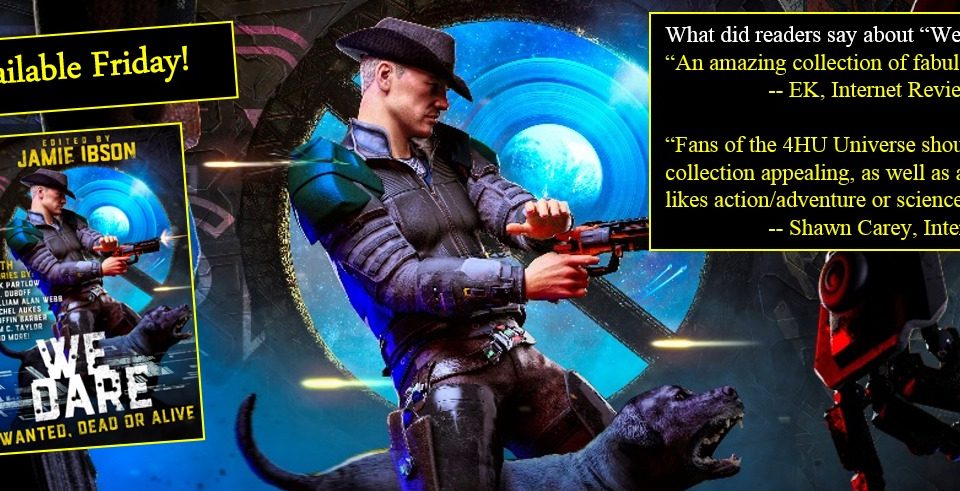
1 Comment
The new book is a fantastic ending to an outstanding series. A must read.